Marina Spironetti has made her home in Italy’s second city and reveals her insider secrets to help you make the most of a weekend visit
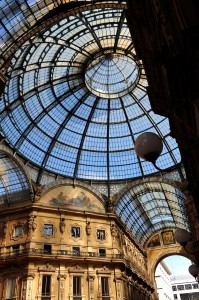 When I made the well-thought out decision of moving back to Milan after 12 years living between London and Paris, a dear friend gave me a guidebook as a present. The title was emblematic, to say the least: “Milan is ugly, very ugly – almost romantic”. Let’s face it. Most Italians don’t like it: a city in the middle of a vast plain, with humid, mosquito-ridden summers and thick fog in winter. Neither do they like the Milanese and their frenetic lifestyle – all they do is work, all they seem to care about is money. Aside from stereotypes, it certainly is an exception within the standard concept of Bell’Italia. Unlike other major cities, it is not brimming with famous attractions. Aside from the Duomo, which is arguably breathtaking, it feels like you have to earn all the other highlights. Still, when you find them they almost come out of nowhere, unexpectedly. And it certainly is a great reward.
When I made the well-thought out decision of moving back to Milan after 12 years living between London and Paris, a dear friend gave me a guidebook as a present. The title was emblematic, to say the least: “Milan is ugly, very ugly – almost romantic”. Let’s face it. Most Italians don’t like it: a city in the middle of a vast plain, with humid, mosquito-ridden summers and thick fog in winter. Neither do they like the Milanese and their frenetic lifestyle – all they do is work, all they seem to care about is money. Aside from stereotypes, it certainly is an exception within the standard concept of Bell’Italia. Unlike other major cities, it is not brimming with famous attractions. Aside from the Duomo, which is arguably breathtaking, it feels like you have to earn all the other highlights. Still, when you find them they almost come out of nowhere, unexpectedly. And it certainly is a great reward.
Getting to the heart of it
Seen on a map, the city centre has the shape of a circle, as if it was drawn with the help of a compass. In its dead centre is its giant cathedral, probably Italy’s finest example of Gothic architecture. Napoleon crowned himself king of Italy here, on a sunny day in the spring of 1805. It was something he was quite used to, after the big coronation in Notre Dame just a few months before. Any tour of Milan should start from here – climb all the way up to its roof (elevator €12; stairs €7) and win your little piece of heaven, among an enchanting forest of spires, gargoyles and statues of saints. Towering them all, at 345ft, is the gilded statue of Our Lady, known as La Madonnina and regarded as the symbol of the city.
Ancient architecture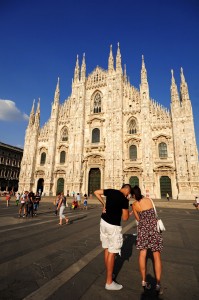
With the Duomo behind you, to your right is the monumental entrance to Milan’s drawing room, the splendid Galleria Vittorio Emanuele II, with its glass and iron-roofed arcade. A true feast for the eyes, with some of Milan’s most exclusive shops and cafés. Stepping on its marble floor is almost like walking down a catwalk, for this is the place to see and be seen. In the centre, under the impressive 157ft glass dome, is a mosaic figure of Taurus. Legend has it that spinning around on the bull’s testicles three times will ensure good luck! Tourists laugh and watch and take pictures, while locals do it with casual Milanese style, swirling their foot on the required spot, then continuing, as if nothing had happened.
The Galleria opens up to Piazza della Scala, address of one of the world’s most famous opera houses. Its plain neoclassical façade hides the magnificence of the interior, still reverberating with the music of the great Italian masters – Verdi, Rossini, Donizetti and Bellini – and the voices of divas like Maria Callas and Renata Tebaldi. From there, the majestic fortress of the Castello Sforzesco is only a short walk away. Originally built by the Viscontis, the rulers of Milan, it was razed to the ground by the townspeople and then rebuilt under Francesco Sforza. It saw several architects and artists involved in its construction, from the Tuscan Filarete, who did the project for the main entrance tower, to Bramante and Leonardo da Vinci. It now houses the Museo d’Arte Antica (€3; closed on Mon) and the breathtaking collection of the Pinacoteca (€3; closed on Mon), with works by the likes of Mantegna, Correggio, Canaletto and Bramante, to name but a few.
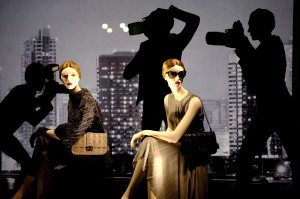 Behind the castle stretches Parco Sempione – Milan’s green lung – perfect for a daytime walk away from the hustle and bustle of the city. At its very far end is the Arco della Pace, Milan’s own Arc de Triomphe. Napoleon commissioned it as a triumphal entrance into the city coming from Simplon Pass and, just like the one in Paris, never saw it finished. Later on, the Austrians ‘converted’ it into a peace monument. It certainly offers one of the most spectacular postcard views of the city, through the marble arch all the way across the undulating grounds of the park and on to the brick castle walls.
Behind the castle stretches Parco Sempione – Milan’s green lung – perfect for a daytime walk away from the hustle and bustle of the city. At its very far end is the Arco della Pace, Milan’s own Arc de Triomphe. Napoleon commissioned it as a triumphal entrance into the city coming from Simplon Pass and, just like the one in Paris, never saw it finished. Later on, the Austrians ‘converted’ it into a peace monument. It certainly offers one of the most spectacular postcard views of the city, through the marble arch all the way across the undulating grounds of the park and on to the brick castle walls.
If you are looking for one of the few old neighbourhoods to survive in central Milan, head into the nearby Brera district as the evening approaches. It’s a magical time of day when the terraces get busy with the comings and goings of waiters, and fortune-tellers sit at their tables ready to look into your troubled love life. Those cobblestoned alleys and their suggestive names give you the impression of being somewhere else – in Trastevere maybe – then you look at the immaculately dressed ladies in their tottering heels and you know you cannot be anywhere but Milan.
For a taste of the vecchia Milano in the evening, have a drink at bar Jamaica (via Brera 32), an old hangout for painters and artists. Although its bohemian feel is now a bit faded, it is one of those places that will probably never go out of fashion.
Step back in time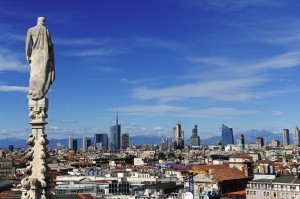
Your second day in Milan could as well start from the same area – art lovers should head to the Pinacoteca di Brera (via Brera 28; €6, closed Mon), yet another heritage of the Napoleonic era. Bonaparte wanted to create a Louvre-like gallery which could house all the treasures he sacked from northern Italy’s churches and monasteries. He did manage indeed, for this is one of Europe’s most exquisite collections. Modest in size but excellent in quality, it covers anything from Raphael, Mantegna, Caravaggio and Bramante. If you are going to visit just one museum during your stay in Milan, I would make sure it’s this one.
Sophisticated fashionistas will then head to the so-called Quadrilatero d’oro, a ‘golden rectangle’ of streets regarded as the heart of the Italian fashion world. Unless you are equipped with a platinum card, the area is perfect for window-shopping. The good news is that the view over the sumptuous 18th and 19th-century palazzi façades is blissfully free of charge.
More to Milan
Time to head south of the centre, into the artsy Ticinese district. The main thoroughfare, Corso di Porta Ticinese, will lead you to the Colonne di San Lorenzo, an unexpected corner of the Roman Mediolanum – 16 Corinthian columns originally part of a temple or bath, which are now swarming with Milanese enjoying their aperitivo. The number one place for a cocktail with a real kick is Exploit (via Pioppette/Colonne di San Lorenzo) but if you don’t want to deal with the scramble to get served, walk the very short distance to Biciclette (via Torti/Conca del Naviglio). A bicycle hanging down from the ceiling evokes the past of this former cycle store, which prides itself on its art exhibitions and its renowned Sunday brunch.
As flat as it is, Milan is a place made to cycle. To do it like a local, register for the city’s bike sharing system (bikemi.it), which works pretty much like the one in London or Paris. Once you are on two wheels, it is surprisingly m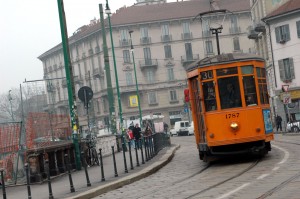 ore difficult than you would imagine. Many streets in the centre are paved, which can make for a bumpy ride. And it gets even harder when you have to avoid the vicious tramway tracks.
ore difficult than you would imagine. Many streets in the centre are paved, which can make for a bumpy ride. And it gets even harder when you have to avoid the vicious tramway tracks.
Yes, let us not forget the orange tram, one of the most beloved symbols of the city – probably coming right after La Madonnina. Everything related to it is reminiscent of long-gone times. Its distinctive noise along the tracks, its wooden seats, its slow-paced nature. On your last night, take the number two to the Navigli district, the lively area of the city’s navigable canals. In times when Milan resembled modern-time Venice, with its intricate network of waterways, this was the working-class district of sailors and dockworkers. Nowadays it’s a bohemian area, with young crowds cramming into the venues along the embankments of the two surviving canals, Naviglio Grande and Naviglio Pavese. Restaurants are cheaper than in the centre and you can listen to some rather good jazz at night.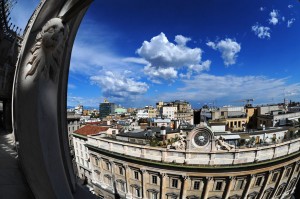
A city for city lovers
Before heading back to your hotel when the city slowly goes to sleep, spare a minute to look at the view from one of the bridges crossing the Naviglio Grande: the austere palazzi, the street lamps reflecting the orange light in the water, the steps of a passer-by going home while a dense fog rises. At that point you might start to get a real handle on the nature of this place, and get a little closer to its core. It is not ugly, but it is certainly romantic. A city for city-lovers, which can surprise you with.
its pure, simple poetry.
For more on Milan, check out our archive
